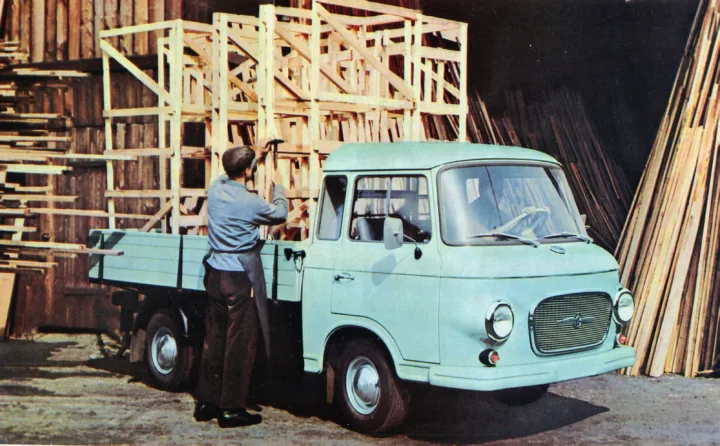Barkas B1000: the first and only
In 1955, East Germany gained full sovereignty and as a result of this long-awaited privilege entered a period of interesting and dynamic political and economic changes. These fully affected the development of the automotive industry, which was put on new tracks, with pre-war concepts becoming history, and all trademarks inherited from the same period being changed. Thus, BMW/EMW became Wartburg, DKW/IFA was renamed Trabant, Phänomen adopted the name Robur, and Framo was now called Barkas. In the second half of the 1950s and in the 1960s, in addition to new names, the products of these automobile factories also received a much more up-to-date design for their time, with Barkas being one of the last enterprises to update its production. In 1961, the completely new B 1000 model was introduced, which, like other East German vehicles of that period, was distinguished by its modern appearance, reliability, and functionality. Its production began in a factory built from scratch in Chemnitz (then known as Karlmarkstadt), built on the site of the old Framo factory, whose facilities were dismantled after the war and transferred to the Soviet Union as part of war reparations alternator valeo pret.

Initially, the B 1000 was powered by a three-cylinder two-stroke engine with a power of 45 hp, also used in the Wartburg, whose concept was similar to that of the pre-war DKW.
For its time, the B 1000 was an interesting and very practical model, thanks to its high payload, front-wheel drive, and unusual suspension, similar to that of the Wartburg, which is rarely found among conventional analogues in the West.
For the entire history of the state-owned East German automobile industry, the Barkas remains the only vehicle with similar functions and capabilities, and therefore various versions and variations have been created on its basis. Variants with a flatbed, a van, a minibus, an ambulance and other specialized versions are available. Thanks to the front-mounted engine and front-wheel drive, the utilization of the cargo compartment is much more efficient and allows for many more configurations.
Barkas are produced primarily for government and public agencies, but limited numbers are also made available to individual customers. In this case, however, delivery times reach heroic levels, comparable to the Trabant waiting times, which vary between ten and fourteen years.
Despite an ambitious start, associated with the launch of completely new East German models in the 1960s (such as the Barkas B 1000 in 1961, the Trabant 601 in 1964 and the Wartburg 353 in 1966), this favorable trend failed to develop, mainly due to a lack of finances. The planned replacement with more modern variants did not materialize and they remained in production without significant external changes until the early 1990s.
Another major problem inherited from the past is the preservation of the archaic two-stroke engines, which were replaced only in the late 1980s with the active assistance of West Germany. Shortly before the end of Barkas production in 1991, it began to be equipped with a 1.3-liter four-stroke engine, produced under license from Volkswagen, and the model designation was changed to B 1000/1. Between 1961 and 1991, a total of 175,740 Barkas B 1000 with a two-stroke engine and about 1,900 with a Volkswagen engine were produced.
- 2025-12-20 - Your worry-free access to Mercedes-Benz Trucks digital services
- 2025-12-19 - Mercedes A-Class before TÜV: solid basic Benz
- 2025-12-18 - BMW Z4: a truly race-bred roadster (retrospection)
- 2025-12-17 - Long live the king? (a return to the world of F1 two decades ago)
- 2025-12-16 - Mercedes R-Class: the road Airbus
- 2025-12-15 - The new Smart is almost 5 meters long!
- 2025-12-14 - Hooray! Another 3 km of the Hemus Highway has been opened
- 2025-12-13 - Porsche has launched a special version of the 911 in honor of visionary designer Ferdinand Alexander Porsche
- 2025-12-12 - They are lifting the ban on internal combustion engines!
- 2025-12-11 - Volkswagen's unknown Mini, created half a century ago












